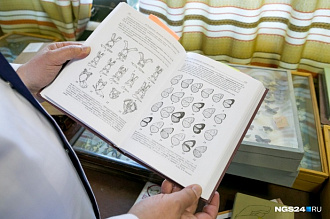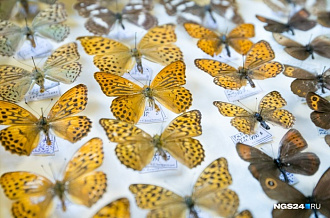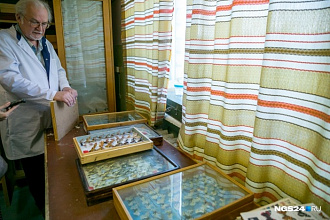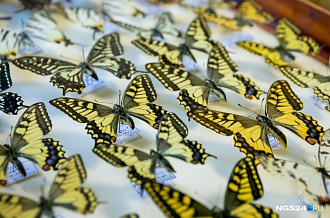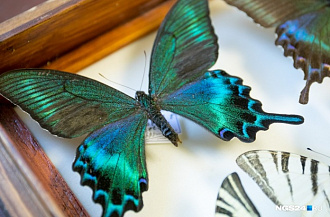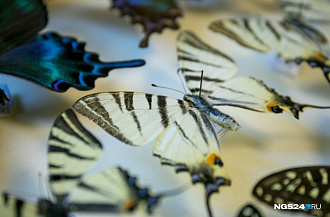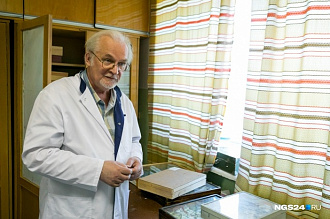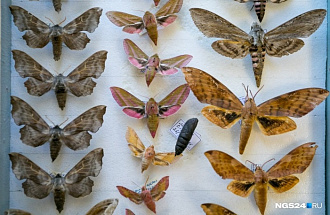“They are thieves, but the beautiful ones”: in the Sukachev Institute of Forest we admire a collection of butterflies which includes thousands of specimens
20 June 2019 г.
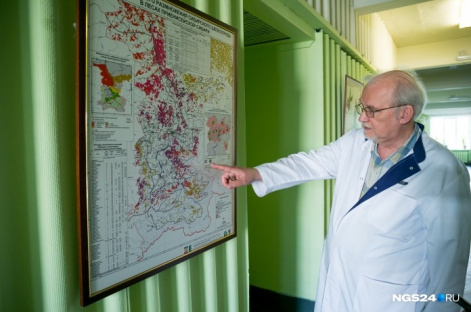
The zoological collection of the museum is stored in a small room in the building of the Institute of Forest. Here, stretched insects- flies, beetles, butterflies are kept in boxes and on shelve stands. The director of the museum, head of the Laboratory of Forest Zoology, Candidate of Biological Sciences Yuri Baranchikov says that the list of the items of the presented collection includes more than a thousand specimens belonging to 40 different families. This is a valuable contribution into the existing collection of the Institute.
All butterflies can conveniently be divided into two large groups: night and day butterflies (rhopalocera). The last name is rather descriptive: the antennas of day lepidoptera have a “club” at the tip. In night butterflies they look in another way: females have funicles, males – brushes intended to catch pheromones released by females.
The butterflies presented in this large collection were amassed manually for many years. Usually, they are caught with a butterfly net but Zakharzhevsky was known among the colleagues for his skill of catching with a jar containing a soporific gas.
To catch a night butterfly one has to be more skillful; it must be attracted by light of an ultraviolet or a usual filament lamp. It is necessary to put two poles with a white fabric stretched between them and the lamp should be placed above the fabric. Butterflies sit down on the cloth, so they can be collected with a butterfly net, jar or pincers.
In order to place the caught butterflies into a collection they must be stretched. In order to open and fix the wings of a butterfly one needs a special device and at least 15 minutes of time: the smaller is the butterfly, the longer the time needed. Ideally, the angle between the axis of the body and the lower part of the front wing must be 90 degrees, in this manner the insect is dried and placed into a collection box. The insect is given two labels: the first one contains the information where and by whom it was caught and the second one indicates the species and who it was determined by.
Zakharzhevsky stored his collection in exhibition boxes and packing cases for old geological equipment. Dried insects can be stored for a long time but they can be destroyed by leather beetles, tiny beetles feeding on dry insects. They exist in every house; one can see them in food or on window sills. Now, to keep the collection safe fr om such insects special plates are put into the boxes, the plates release vapors of insecticides which kill the undesirable insects. The plates are to be changed once half a year, allowing one to increase the bright but so short time of the butterfly existence.
How do butterflies live?
Like other herbivorous insects, all butterflies appear from eggs laid on a forage plant. A caterpillar hatches and feeds on this plant. Its shell is rich in chitin, which does not allow the caterpillar to grow, thus, during its life the insect sheds its old skin 5-6 times. The existence of a caterpillar does not exceed one and rarely, two months. Some species, for example, a night butterfly Siberian silkmoth can live in the form of a caterpillar for 2-3 years and even hibernate in this manner.
At the final stage of its development the caterpillar turns into a pupa, and then, into a butterfly. The newly born butterfly must necessarily find a vertical or slanted surface and get fixed on it. It is necessary for its wings to be filled with hemolymph and be stretched under the influence of the gravitation force.
— I often remember a funny case — a university student was writing some work on the influence of city pollution on butterflies at the example of the satin moth. They picked up pupae, put them into petri dishes and there, butterflies appeared. The butterflies had deformed wings. There was even a publication which informed about the terrible ecological situation in the city resulting in so ugly butterflies. But if this dish had been tilted for the gravitation force to act on the butterflies, all of them would have been normal. Pollution is not the case here, just it is the lack of information, says Yuri Baranchikov.
Having stretched out the wings, adult insects begin to search for a partner. Usually, day butterflies choosing a partner pay attention to the color. Some species of Lepidoptera even have courting rituals. For example, Leptidia sinapis sit opposite to each other and the male begins to stroke the female’s antennas with his own ones. Some males are rejected, others are allowed to approach closer.
— If you are attentive you will see that males have hooks from behind to catch a female during mating. It is necessary in the case of danger. The process is long and the butterflies are easy to catch. If there is a shadow nearby, for example, a bird, they fly up. The female is usually bigger, it flies and the male is attached from behind; you must have seen it many times, says the scientist.
Almost immediately after mating, butterflies fly to lay eggs – some of them lay eggs directly on forage plants, others, such as Erebia, fly and scatter eggs from the air. Usually, day butterflies lay from 50 to 100 eggs, night butterflies can lay up to 300 eggs, however, at this stage they also have a high mortality rate of up to 90%, as there are too many “butterfly eaters” around. The butterflies themselves do not care about their eggs and, like the cuckoo, leave the offsprings on their own to survive.
Having transformed into a butterfly, insects do not live long. Some species, such as the Siberian silkmoth and gypsy moth, do not even eat in the butterfly stage. They can live no longer than a month, and only if there is gloomy weather and the insect is not active.
- They have a proboscis, but this is already a rudiment, like an appendage in humans. Silkworm moths live off their stock. If the temperature is high, they will live shorter, as they will quickly use up their energy. In normal conditions, they live no more than 2 weeks - says the head of the museum.
Are butterflies useful or harmful?
According to the scientist, there are species of butterflies which cause obvious harm to humans. For example, the Machaon butterfly, which is popular in Krasnoyarsk. It is included in the IUCN Red List, but its caterpillar can feed on Apiaceae in gardens - carrots, caraway or dill. Among the pests there is also the cabbage white - a European species which first appeared in Siberia 30–40 years ago, at about the same time as the Colorado potato beetle.
In the last two years, breeding grounds of the Siberian silkmoth have been observed in the region. Silkmoth caterpillars eat away needles, resulting in the death of trees.
- They eat away foliage completely, and a completely bare forest is observed in the areas of hundreds or thousands of hectares. In the case of larch, the trees can still produce secondary needles by the end of the season, but in the case of spruce, cedar or fir, they die very quickly. Last year the silk moth outbreak covered about a million hectares in the north of the Krasnoyarsk Region, wh ere fir is widely spread. The federal government has allocated half a billion to treat the regional forests from the silkmoth, there was a lot of information about this in the media,” says Yuri Baranchikov. There are also "cunning" species of butterflies. For example, gossamer-winged butterflies of the Maculinea genus. The caterpillar settles on the flowers of leguminous plants and during one of the molting its starts emitting a specific odor attracting ants. The ants drag her to their nest and treat it as their lost larva. The caterpillar is fed by chewed insects, but, in addition, it eats the larvae of ants.
It is believed that butterflies also bring benefits - they collect nectar from flowers and, thus, participate in plant pollination. However, the scientists say the butterfly’s merit is far overestimated. - There are numerous studies, showing that this is not the case. Butterflies mostly steal nectar. It is bees and bumblebees that take part in pollination - they climb inside the flower and crawl out from there completely covered with pollen, while butterflies act as surgeons - they keep their distance and climb into the flower with a proboscis. Of course, they can pick up something from the pollen, but this is not significant as compared to the merits of bees. Therefore, as a rule, butterflies are thieves, though beautiful ones, says Yuri Baranchikov.
Share:

